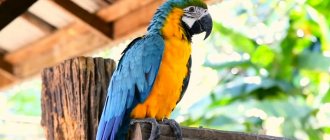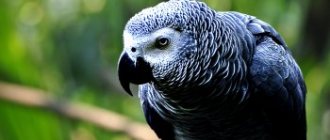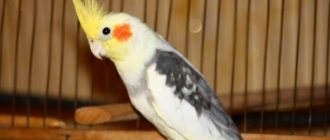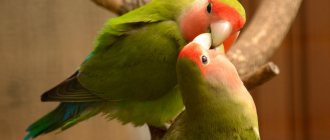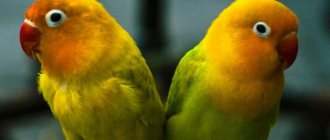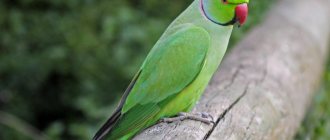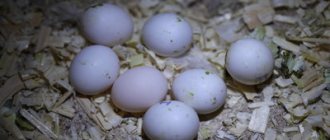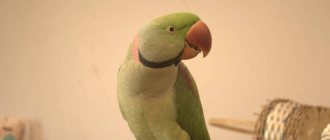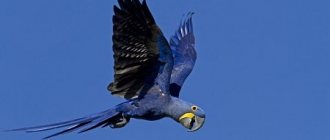Breeding pet parrots is the dream of many novice breeders of exotic birds. However, organizing a successful “parrot farm” requires not only time and some investments, but also compliance with many nuances.
It is important to find out how many days a female parrot incubates eggs, how to calculate the best time for mating of individuals, choose a suitable pair, and provide the birds with proper nutrition.
Secrets of egg production
Reproduction of parrots occurs according to the same principle as in most birds: a fertilized female lays eggs, from which chicks subsequently hatch. In this case, one mating pair can “infect” others with the desire to reproduce. Therefore, do not worry if a couple of parrots in a cage are in no hurry to reproduce. It may take them a long time to look at each other, want to mate and lay an egg.
The period of sexual maturity for different species of parrots can be different. For example, Budgerigars are the “earliest”, they can be prepared for breeding at 9 months, and larger birds at 1.5 years or more. The optimal period for reproduction is spring and summer. Note that a female parrot at home is quite capable of laying eggs without the company of a male.
The answer to the question of why this happens is considered to be a reaction to excess protein food in the diet. If you find an egg in a female's cage, you will need to consider an additional source of calcium for her. After all, birds spend a lot of this mineral on the formation of the shell (the video below explains in detail about this phenomenon and what to do in this case).
How does reproduction occur?
The signal for breeding for budgerigars in captivity is usually the hanging of the nesting box. However, even if you don’t do this, and the couple is ready, they can start the process without a house, limiting themselves to what they have. But it is better to provide a house, and it is also necessary to provide the couple with material for comfortable arrangement of the nest: paper, cotton wool, ropes, etc. You can pour sawdust into the house - this will create a soft substrate for future offspring. However, do not use sawdust from coniferous trees, it is of no use. It will be great if the walls and roof of your house are held together with screws, then you can easily replace damaged parts of the plywood house with new ones in the future, without having to buy a new “mansion.” During this special period, the behavior of birds changes significantly, especially in the female. She becomes more demanding and aggressive (may even tear up the bedding at the bottom of the cage). During this period, she is very lacking in minerals, which must be present in abundance in her diet. The cere in both individuals changes color slightly – it becomes brown. The male becomes more attentive to his partner and tries to please her in everything. Budgerigars (like other birds) do not have external genitalia. Mating occurs due to the contact of the cloaca of the male and female. This is preceded by a short courtship ritual, when the male scratches the feathers of his chosen one and treats her with delicacies. Females have one ovary and one oviduct, which opens into the cloaca. The male has a pair of testes with canals that also exit into the cloaca. When the wavy cats mate, the female tries to position herself from below to allow the male to press as closely as possible to the area under the tail.
About the secret
The mating process in parrots is preceded by incredible mating games. The male's arsenal includes dancing on a perch, mating, and peculiar “kisses” on the beak. At the same time, he can frantically knock his beak against everything in the cage. The apogee of courtship is joint feeding. When the female has accepted the male's treats, which he regurgitates during his advances, consider the job done.
Also, during the courtship process, the birds mate several times a day. To do this, the female crouches to the floor, and the male climbs onto her back, as if enveloping the “bride” with wings and fertilizes her. About a week after these actions you can expect the first egg. The female, who is about to lay an egg, becomes extremely playful, and her tail performs rhythmic pendulum movements. You can watch the entire love process of parrots in the video below!
The appearance of chicks
At the end of the incubation period, a chip appears on the shell - this is the chick that begins to hatch. At the tip of the beak there is a thickening, an egg tooth, with which the bird cracks the shell. If the baby is not strong enough, the mother herself cracks the shell, helping the chick escape. Delivery "requires high humidity, otherwise the inner foil may stick to the skin of the chicken.
Budgerigar chicks
Newborn budgies weigh only 1-2 grams. They are blind, naked and completely helpless - initially they cannot even roll over. They gradually dry out, and single flakes are visible on the skin. Chicks begin to meet within a week. The mother feeds them goitrogens.
The difference between the first and last baby can be a little more than a week. It’s easy to calculate how many days whole eggs can remain in the nest: chicks should wait no more than four weeks. Empty clutches should be removed to allow the female to complete the brooding process and fully care for her offspring.
When a pet parakeet is incubating eggs, there is no need to interfere with the process, no matter how interesting it may be. Human assistance to animals can take the form of feeding, creating a favorable microclimate and a peaceful environment. The bird's natural instincts will tell you how to hatch and care for the young.
Hatching process
If you don’t yet know how many eggs are in a parrot’s clutch, we’ll answer: on average, from 5 to 8 eggs (maybe 12). When the first egg appears, the female will lay the remaining eggs every other day. Only the female will do the incubation; for this purpose, a so-called “incubation spot” is formed on her belly. This is a special place on the belly of a “pregnant” female, which is filled with blood, swells and emits the heat necessary for incubation.
While the female sits diligently on the eggs, the male feeds her. Considering that a female parrot lays a clutch literally from the first egg laid, her chicks will not be born at the same time.
parrot nest
In the wild, parrots nest in hollows. Therefore, when you hang a nest in a cage with your birds, this will additionally stimulate them to reproduce at home. You can hang a nest in a cage from wood or plywood, or from plastic, you can make a nest yourself, or you can buy a ready-made version. The standard size of a nest for a budgie is 16 x 16 cm with a height of 25 cm. The inside of the nest is lined with sawdust.
In our video below you can watch how interesting the female reacts to the appearance of a nest!
Duration
The duration of incubation varies slightly among different species of parrots:
- Budgerigar chicks will celebrate their birthday in 18 days;
- The birth of Corella chicks should be expected in 19 days;
- Rosella in as many as 26 days;
- for Ringed and Ringed parrots, the incubation period is 23-28 days;
- for large Cockatoos it is 25-28 days;
- for Lori – 24-26 days;
- little Lovebirds will be born in about 23 days;
- and Jaco’s birth should be expected in 29-30 days.
How do chicks hatch?
When the time comes, the parrot chick emerges from its shell like all other birds. It uses its “egg tooth” to make its way through, and with the help of intense movements of its wings it finally gets out of the egg. His mother willingly helps him with this. Next, we invite you to watch a touching video about the birth of a little parrot!
The chick is born completely helpless and weighs from 1 to 1.6 g. The mother is responsible for its further heating and feeding. The birds gain weight rapidly, and gradually only the father parrot begins to feed them. It will take approximately 35 days from birth before the chick is fully fledged and ready to live independently.
Caring for chicks
We found out how many eggs a budgie hatches. 25 days flew by, the first babies were born - red, wrinkled and very ugly. How to care for offspring?
The baby does not require special care. For the first two weeks they should not be touched. After 14 days, carefully bathe the babies in warm water. This is necessary in order to cleanse their bodies of adhering droppings.
There must be sprouted grain in the cell. It is eaten by the female to produce crop milk. In addition, a young mother needs green supplements. Lettuce, dandelion, and plantain are ideal options for meeting your green needs.
About 3 weeks after birth, small chicks begin to eat softened grain. They leave the nest on the 40th day of life.
What to do if your parrot laid an egg?
If this was part of your plans and you want your birds to have offspring, then you urgently need to hang a nest for the parrots. Then the bird will take up incubation. There is no need to help her or do anything; parrots always manage on their own. It is also not worth removing her gentleman from the cage, unless, of course, he slightly distracts her from an important process. If the female lives with you alone and suddenly begins to lay eggs, then you should reconsider her diet and slightly reduce daylight hours.
Help for feathered parents
For successful reproduction and the appearance of healthy offspring before nesting, it is necessary to take measures to improve living conditions:
- With the help of a bath, the female maintains the required humidity in the nest. If the cage measures 60×30×40, it is advisable to increase the dimensions or exchange it for a new home. This is due to the fact that parrots show aggression in cramped cages and do not nest.
- Installation of a bathtub is required. During nesting, the female uses wet feathers to maintain the level of humidity necessary for the development of the offspring.
- Daylight hours are gradually increased to 16 hours with the help of additional lighting.
- Withstands indoor temperatures not lower than +18°. At a lower temperature, the pet’s body maintains its own body temperature to consume nutrients, and the offspring does not receive enough heat.
- During nesting, silence is ensured indoors. Loud noises are not allowed.
- Before mating games, the cage and installed equipment are disinfected to prevent parasites and the occurrence of infectious diseases.
- Add additional calcium-containing fertilizers. Chalk, sepia and mineral stone should be freely available.
Cleaning is carried out depending on the emotional state of the female and the number of chicks. After waiting for the mother to leave, sawdust is poured into the cage and the dirt is removed. The frequency of cleaning is determined according to the degree of contamination.
Video "Parrot Breeding"
Finally, a video talking about various aspects of parrot breeding and possible problems that can accompany this process!
Sorry, there are no surveys available at this time.
Was this article helpful?
Thank you for your opinion!
The article was useful. Please share the information with your friends.
Yes (100.00%)
No
X
Please write what is wrong and leave recommendations on the article
Cancel reply
Rate the benefit of the article: Rate the author ( 3 votes, average: 4.33 out of 5)
Discuss the article:
Selecting an incubator
You can buy the device or make it yourself.
It is recommended to focus on purchased models that are equipped with useful functions that allow you to maintain optimal temperature and humidity.
Pet stores offer a huge range of such products, which differ in size, built-in functions and cost.
Since you plan to grow wavy plants, it is advisable to choose models with a small laying.
Incubators for chicken eggs are usually purchased, and devices designed for three embedded materials are considered ideal.
When choosing a product, the following parameters are taken into account:
- a reliable housing that is hermetically sealed and does not let heat out;
- the tray should be presented as a flat container, but the eggs should not be rolled out, so they should be stored in the position in which a person leaves them;
- the turning device is offered only in expensive models, so to save money you can choose a product without it, but you will have to perform these actions manually;
- an electric heater is usually represented by an ordinary incandescent light bulb, and with its help the optimal temperature for the development of embryos is established;
- the cooling function is offered only by a limited number of devices, and without it you will have to ventilate the incubator yourself;
- Humidification is provided by automatic spraying of water, which makes it much easier for the chicks to break the shell, but in the absence of this function, you will have to spray the embedded material yourself from a regular sprayer.
It is recommended to purchase a battery-powered device, although it is expensive, but if the electricity in the apartment or house is turned off, the equipment will continue to work, so you don’t have to worry about the life of the embryos.
Before using any purchased device, study the instructions , thanks to which you can correctly configure the options that are optimal for growing wavy plants.
This is what a homemade incubator looks like:
More information about the incubator for budgie eggs in the video:
Dead embryos
The embryo can die at any stage of incubation. To avoid infection, it is necessary to promptly remove those wavy eggs whose contents begin to decompose. After the death of the embryo, the egg begins to turn gray, and the more days pass, the grayer it becomes.
From the tenth day, the embryo in a living egg, when turned, slowly and smoothly returns to its position; in a dead egg, it floats freely, and does not return to its original position. If the contents have long since begun to decompose, instead of the embryo there will be a dark clot or sediment.
To inspect eggs, it is good to use an ovoscope, but if you don’t have one, a lamp will suffice: when you hold the eggs up to it, it is convenient to examine them in the light. In the first days, you can see a regularly shaped yolk in a living egg, and on the 10th day, if development is normal, you can see the blood vessels of the future parrot. By the 15th day, the egg becomes dark when exposed to light because the chick is almost formed.

